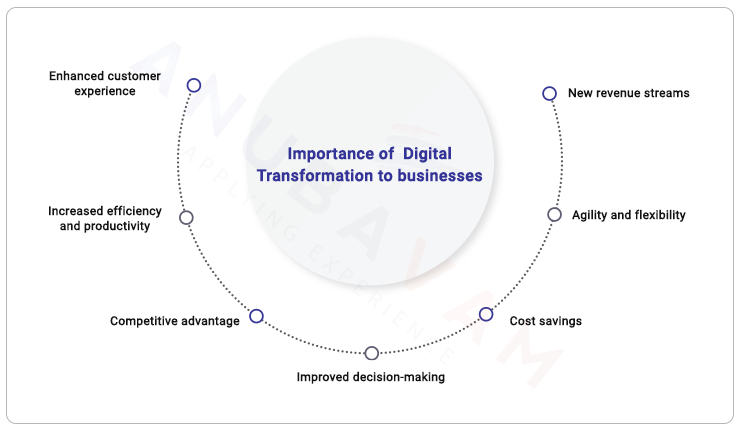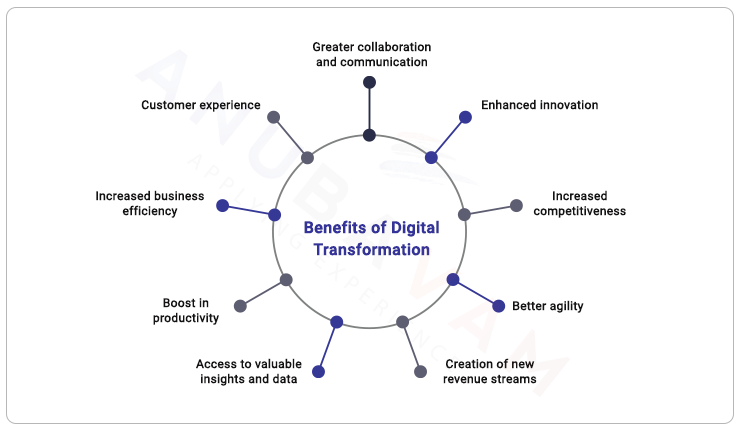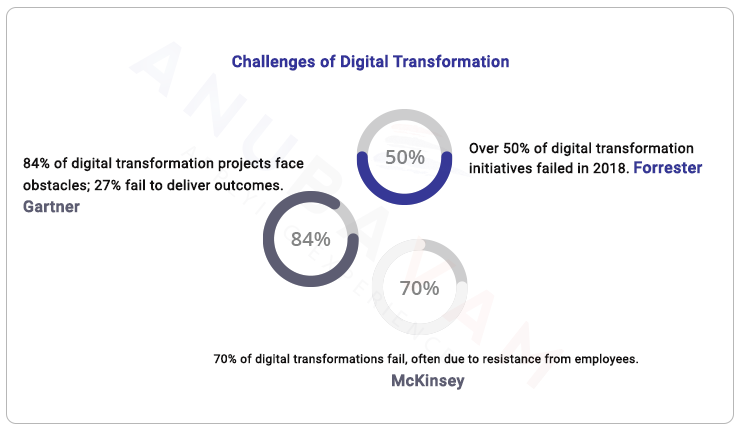The Challenges and Benefits of Digital Transformation in Business

Introduction The phrase "digital transformation" has gained popularity in today's quick-changing business environment. Companies across all industries are striving to embrace the latest digital technologies to stay competitive and meet the changing needs of their customers. While digital transformation offers numerous benefits, it also poses several challenges. A study by IDC found that only 29% of companies have a formal digital transformation strategy in place. This indicates that many businesses are struggling to even begin the digital transformation journey, let alone complete it.
Let us explore the challenges and benefits of digital transformation in business and provide insights and best practices to help organizations navigate this complex process successfully.
What is Digital Transformation?
The process of leveraging digital technology to fundamentally alter how businesses function and provide value to customers is referred to as "digital transformation." It involves integrating digital technology into all areas of a business, including its operations, customer service, marketing, and product development.
The term “digital transformation: is driven by several key business mandates
- Rethink old operating models
- Replace obsolete or legacy technology
- Experiment more and embrace innovative ideas
- Become more agile in the ability to respond to customers and rivals
- Rethink top-down management ideals and implement more useful bottom-up management systems.
The goal of digital transformation is to enable organizations to better adapt to the changing needs and expectations of customers in a digital age, to improve business efficiency, and to create new revenue streams. This often involves the use of data analytics, artificial intelligence, machine learning, and other emerging technologies.
Why Digital Transformation is important for businesses today?

Digital transformation is important for businesses today for several reasons:
Meeting the changing customer expectations: Customers are increasingly expecting businesses to offer seamless and personalized experiences across all channels, from online shopping to customer support. Digital transformation enables organizations to meet these changing expectations by integrating digital technology into all areas of their business.
Improving business efficiency: Digital transformation enables businesses to automate manual processes, digitize data, and utilize machine learning and artificial intelligence, leading to increased productivity and cost savings.
Accessing valuable insights and data: By collecting and analyzing customer data, businesses can gain a better understanding of their customer's needs and preferences, and tailor their products and services accordingly. This can help businesses stay ahead of the competition and identify new growth opportunities.
Innovating and creating new revenue streams: Digital transformation enables businesses to explore new business models and create new products and services. This can help businesses remain relevant and competitive in an ever-changing market.
Benefits of Digital Transformation. Why does it matter?

Digital transformation offers numerous benefits for businesses including,
- Improved customer experience and satisfaction
- Increased business efficiency and productivity
- Access to valuable insights and data
- Creation of new revenue streams
- Better agility in responding to customer needs and market changes
- Increased competitiveness in the digital age
- Enhanced innovation and experimentation
- Greater collaboration and communication across the organization
Challenges of Digital Transformation
Digital transformation offers organizations the chance to transform their business operations by adopting new digital processes and tools. Nevertheless, like any change management initiative, businesses will encounter challenges throughout the transformation process.
- According to Forrester, over 50% of digital transformation initiatives failed in 2018
- A 2019 study by Gartner found that 84% of digital transformation projects face obstacles and 27% of them fail to deliver any business outcomes
- Another study in 2019 by Altimeter found that only 25% of digital transformation initiatives achieved their goals, with the remaining 75% falling short or failing altogether
- Similarly, McKinsey found that 70% of digital transformations fail, often due to resistance from employees.
- Only a small percentage (16%) of employees reported that their company's digital transformations had improved performance and were sustainable in the long term, according to McKinsey

Why digital transformation poses such a significant challenge is a question that needs to be explored.
The rise of agile-oriented digital companies has transformed various aspects of human life, from transportation to communication and shopping. Traditional companies are feeling the pressure to adapt to this change as the competition becomes more robust than ever.
However, handling digital challenges alongside current business processes, stakeholders, and customers can be a difficult balancing act. It can be particularly challenging for companies that specialize in non-IT fields to choose the right digital transformation technology for their business.

To overcome these challenges, it's important to partner with a reliable digital transformation consultancy agency that can provide the right expertise and guidance. The process impacts not only the company and employees but also its stakeholders. Therefore, it's crucial to approach digital transformation with care and diligence. We have explored five common challenges of digital transformation and their solutions.
Organizational culture
These are the shared values, beliefs, attitudes, and behaviors that shape how people in an organization interact with one another, make decisions, and approach their work.
One of the challenges associated with organizational culture is when an organization's culture is misaligned with its strategic objectives or fails to promote diversity, equity, and inclusion. This can lead to low employee engagement, decreased productivity, and difficulty attracting and retaining top talent.
Solution: To address this challenge, organizations can define and communicate the desired culture, align culture with strategy, foster diversity, equity, and inclusion, empower employees, and continuously monitor and evolve the culture.
Research has shown that organizations with a strong culture that aligns with their strategy are more likely to outperform their peers, while companies with a more diverse workforce are more innovative and have higher financial performance.
By prioritizing organizational culture and taking steps to improve it, organizations can improve employee engagement, productivity, and innovation, and ultimately achieve greater success.
Agility challenge
The Agility Challenge refers to the difficulty that organizations face in quickly adapting to changing market conditions, emerging technologies, and shifting customer demands. This can result in a loss of competitiveness, missed opportunities, and ultimately, a decline in revenue and growth.
Solution: To address this challenge, organizations can adopt agile methodologies, prioritize data-driven decision-making, promote continuous learning, foster a collaborative culture, and adopt a customer-centric focus.

A study by PwC found that companies with a strong focus on data-driven decision-making are three times more likely to report significant improvements in decision-making and have a 12 times higher likelihood of achieving double-digit revenue growth. Hence, this is something that can be adopted too.
Lack of clarity on the budget
The lack of clarity on the digital transformation budget refers to the challenge that many organizations face in accurately forecasting and allocating resources for their digital transformation initiatives. This can lead to overspending, underspending, and delays in project completion.
Solution: To address this challenge, organizations can take a structured approach to budgeting and allocate resources based on a clear understanding of their digital transformation goals.
Establishing a clear digital transformation roadmap that outlines specific initiatives, timelines, and resource requirements. This roadmap should be aligned with the organization's strategic objectives and be based on a thorough analysis of current processes, systems, and capabilities.
By having a clear roadmap, organizations can better understand the resources needed to achieve their digital transformation goals.
Another solution is to prioritize digital transformation initiatives based on their potential impact on the organization's bottom line. According to a study by McKinsey, companies that prioritize digital initiatives based on their potential impact on revenue growth and cost reduction are more likely to achieve their transformation goals. This approach can help organizations focus their resources on initiatives that are most likely to drive meaningful business outcomes.
Similarly, organizations can adopt a culture of continuous improvement and experimentation to ensure that their digital transformation initiatives are agile and flexible. By embracing an iterative approach to digital transformation, organizations can quickly adjust their strategies and resource allocations based on feedback and results.

Siloed organizational structure
A siloed organizational structure can hinder collaboration and communication between departments, making it difficult to implement digital transformation initiatives that require cross-functional teams.
Solution: Companies should implement a culture of collaboration and break down silos by encouraging cross-functional teams to work together on digital transformation initiatives. They should also create a governance structure that promotes collaboration and communication across the organization.
Integration with legacy systems
Many organizations have old systems that were not designed to be integrated with modern digital technologies. Integrating legacy systems with new digital solutions can be complex and costly. It can also lead to data silos that hinder communication between different departments within the organization.
Solution: To overcome this challenge, companies can develop a roadmap for system modernization and prioritize the most critical systems for integration. They can also use middleware solutions that act as a bridge between legacy systems and modern digital technologies, allowing data to flow seamlessly between them.
Additionally, they can adopt cloud-based solutions that can integrate with legacy systems and provide a more scalable and flexible solution. APIs provide a bridge between different systems and allow them to communicate with each other in a standardized and secure way.
According to a survey conducted by MuleSoft in 2020, organizations that have implemented APIs as part of their digital transformation initiatives have seen significant benefits, including increased productivity, improved customer experience, and faster time to market.
The survey found that businesses with APIs were 2.2 times more likely to have launched new products and services and 2.5 times more likely to have expanded their customer base. In addition, companies with APIs reported 61% faster project completion times and a 20% reduction in integration costs.
Cybersecurity
As digital transformation involves the use of new technologies and devices, the risk of cyber threats increases. Companies need to ensure that they have the necessary cybersecurity measures in place to protect their data, their customer's data, and their systems from cyber-attacks.
Solution: To address this challenge, companies need to have a cybersecurity strategy in place that includes regular risk assessments, employee training, and strong authentication and access control measures. They should also use encryption and other security measures to protect data both in transit and at rest. Companies can also partner with third-party cybersecurity experts to provide additional layers of protection and guidance in implementing cybersecurity best practices.
Making sure you comply with relevant data privacy laws and regulations, such as the General Data Protection Regulation (GDPR) and the California Consumer Privacy Act (CCPA), also helps.
Strategies for Successful Digital Transformation
Digital transformation is a complex process that involves leveraging technology to transform an organization's business processes, operations, and customer experience. To succeed in this endeavor, organizations need to develop and implement key strategies that will help them achieve their goals. We have explained each one of them in detail below.

Define a clear digital transformation strategy
Organizations should have a clear understanding of why they want to embark on a digital transformation journey and what they hope to achieve. A well-defined digital transformation strategy should align with the organization's overall business strategy and take into consideration the needs of all stakeholders.
Embrace a customer-centric approach
Organizations should prioritize the needs of their customers and focus on delivering exceptional customer experiences. They can obtain insights into client behavior and preferences by utilizing data analytics, and they can then customize their products and services to match those needs.
Adopt an agile approach
Digital transformation is an iterative process that requires organizations to be agile and adaptable. Organizations should be willing to experiment, learn, and adjust their strategies based on feedback from customers and employees.
Build a culture of innovation
Organizations should encourage innovation and creativity by providing employees with the necessary resources and tools to experiment and develop new ideas. This can help organizations stay ahead of the curve and drive growth and competitiveness.
Develop strong partnerships
Organizations should build strong partnerships with technology vendors, consultants, and other stakeholders to gain access to the latest technologies, best practices, and expertise.
Invest in talent development
Digital transformation requires a skilled workforce with expertise in areas such as data analytics, cybersecurity, and cloud computing. Organizations should invest in talent development and provide employees with opportunities to learn new skills and advance their careers.
Conclusion - Key takeaways for businesses considering digital transformation
Digital transformation is a complex process that requires a strategic approach and a commitment to innovation, agility, and investment in technology and talent. To successfully navigate this process, businesses should prioritize a customer-centric approach, invest in developing a culture of innovation, and be willing to adapt and experiment as they implement their strategies.
Building strong partnerships with technology vendors and other stakeholders can also provide organizations with the necessary resources and expertise to achieve their goals. Anubavam Technologies is a leading provider of digital transformation services, offering a wide range of solutions, including cloud migration, legacy application migration, AI, and cloud-based platforms. With deep expertise, Anubavam can help businesses overcome the challenges of digital transformation and leverage the benefits to achieve sustainable growth and success. Contact the team today to learn how our digital transformation services can empower your business for the future.
Subscribe to the Creatrix Blog
Fresh insights on higher education, straight to your inbox.
We respect your privacy.
Want to contribute?
We welcome thought leaders to share ideas and write for our blog.
Become a Guest Author →
